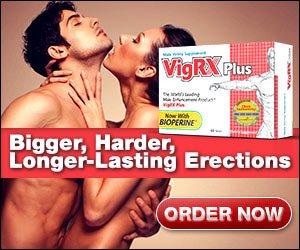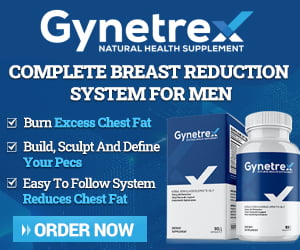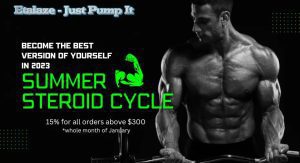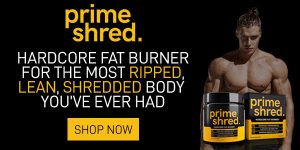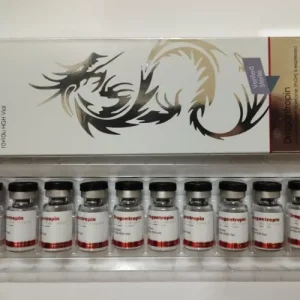Supplements
Bodybuilding Protein Cycling for Massive Gains
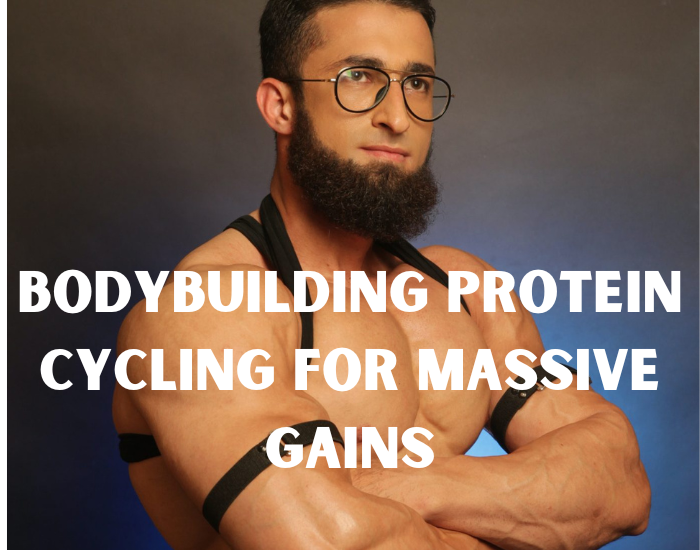
Mistakes, Protocol, Pros and Cons
There is no bodybuilding without protein. Protein cycling(PC) is a strategy where bodybuilders alternate between high, low, and average protein consumption. A high-protein diet is a secret to hardcore bodybuilding, but it will not help you maintain the perfect body; protein cycling does. Your body needs various kinds of proteins to grow and strengthen muscle naturally and from supplements. Protein cycling is based on measured protein consumption from considerable amounts of protein and different sources, generally within a two-week cycle.
However, high protein consumption, for a long time, has been found to induce anabolic resistance. Athletes such as bodybuilders must pay attention to how their body rehydrates, replenishes, and repairs after every exercise. That will help you adapt to training faster than usual and reduces the chances of getting fatigued. Additionally, skeletal muscles normally mass with aging.
Related Article:: Protein Powder Supplement Comparison – Which Type To Choose?
Anabolic resistance refers to reduced muscle ability to stimulate protein synthesis. Aging comes with anabolic resistance even though feeding-induced simulation remains constant. However, some elements of feeding resistance affect their protein intake significantly for some people.
Helpful Facts in Protein Cycling
You should take one gram of protein per pound of body weight. Every fitness enthusiast must follow this religiously if they want to have an enviable body. Most fitness professionals have achieved a lot body-wise by ensuring their body is not short of proteins needed for MPS. Additionally, they can take only what will contribute to muscle growth without necessarily adding extra pounds of fat. If you weigh 250 pounds, you must take anywhere between 240 and 260 grams of protein daily.
Although this might be difficult to achieve due to many factors, it is important to ensure it is done four days a week. Otherwise, you might not complete the required muscle mass. Moreover, your exercise rate and intensity will dictate whether you need slightly more or less of the recommended amount. Elite bodybuilders, for example, can take up to 2 grams per pound of their body weight. If a bodybuilder wants to increase protein synthesis and nitrogen retention, they must take high-protein foods like beef, fish, chicken, etc.
Muscle Growth
Rapid muscle growth does not only stop at taking more protein. It involves taking them correctly and with carbs. Additionally, the diet must also include proper fat intake. The trick is to balance the three, not substituting one with the other. As mentioned earlier, taking too much or too little protein might not achieve the desired results as far as bodybuilding and fitness are concerned. It doesn’t matter whether your body is natural; only take the protein it can accommodate.
Also, people are wrong to assume that carbs are entirely bad and proteins are reasonable. As long as the balance is maintained, then you’re good to go. Fats, on the other hand, are a bit different. The fact about fats is that you will get fat if you take more fat, but the reverse is invalid. Depending on your routine, only take a certain amount of fat daily. For instance, you cannot take the same amount of fat when doing intensive exercises and light ones like just training your shoulders. You will need more energy to do deadlifts and other full-body routines; most of that energy comes from burning fat.
Protein Cycling Protocol
Excess fasting and protein cycling are undoubtedly the best way to slow down aging for bodybuilders. Additionally, there is growing evidence that protein cycling helps prevent cancer, heart disease, and diabetes. While the average human takes about 70 grams of protein daily, bodybuilders need about twice to maintain muscle mass. A typical bodybuilder protein cycling involves halving protein intake within the first five days and doubling it afterward. Depriving your body of proteins within the first five days enhances autophagy, which is your body's process of carrying out protein recycling.
Today's greatest bodybuilders have successfully stimulated more excellent protein retention through protein cycling. And that is precisely where the secret to their success lies. Unknown to many, protein cycling is not something easy to go about. The truth is that many people struggle to make this dream a reality, something that has dramatically affected their fitness careers. For bodybuilding newbies, we will show you the steps you can use for proper protein cycling.
Step 1: Reduce Protein Intake for the First 5 Days
For about five days, reduce the amount of protein you take considerably to maybe half the amount you used to take. However, it is recommended that you take not more than 1 gram of protein per 1 pound of body weight within those five days and see how your body responds to the change. It would help if you weren’t worried that you might shrink within those few days. No, it takes much longer for your muscle mass to show a significant reduction. However, be careful not to take too little protein during that period. You must not go below 0.5 grams per pound of body weight.
Although your body may change its metabolic rate to accommodate protein deficiency, there is a specific limit on how much change it can sustain. The resulting anti-catabolic effect from reduced protein metabolism has been found to enhance muscle growth. Regularly decreasing your protein intake induces muscle preservation in your body. At the same time, your muscles will be growing at almost the same rate as before. The result is increased muscle mass over a relatively short period.
Step 2: Increase Protein Intake After 5 Days
Up your protein intake after the first five days. Remember that the first step involved reducing protein consumption to induce enzymatic anti-catabolism. Once you switch gears in this second stage and start taking more protein, your body accumulates more protein and builds muscle. The enzymes that cause protein anti-catabolism will slow metabolism, while the protein consumption surge will enhance muscle growth. Bodybuilders with more than 200 pounds should start taking between 1.5 and 1.8 grams of protein per pound at this stage. You should increase the rate to 2 grams per pound daily for ten days if you’re on a two-week cycle. All this is geared towards helping the body achieve a hyper-anabolic state, highly enzymatic and ideal for muscle growth.
Must Read:: Best Diet Plan for Bodybuilders 2019
Protein Cycling Mistakes to Avoid
Protein cycling may not achieve your desired results if you don’t do some things right. Here are some protein cycling mistakes to avoid.
1. Taking More Than You Can Sustain
Some bodybuilders are impatient and want instant transformation. While bodybuilding is about gratification, be careful not to overwhelm your body with proteins. Most protein foods promise quick results with certain restrictions in terms of what amount to take and how to take it. It is very tempting to bypass such requirements and do everything you like. That is disadvantageous from many angles. One is that you may take in extra calories, which may not help you achieve the ideal muscle mass.
Gold Standard >> Buy It <<
Similarly, taking protein foods with meager calories and too many of them may experience painful weight loss. You are not supposed to lose more than the recommended weight as a bodybuilder because it might take longer to recover. Most people will generally gain their weight back after six months. That is a bit too long in professional bodybuilding and fitness. It would be best never to take in more protein than your body can sustain.
2. Changing Programs Frequently
You can only engage in beneficial protein cycling if you stick to one working program. Unfortunately, many bodybuilders may hop from one program to another, which is not advisable. The reason is that you may erase the gains you have made in the previous cycling program when you shift to a new one. Additionally, you may not get any results if you are not patient enough to finish the program. There is no other secret to getting results in protein cycling except patience and consistency with the chosen program. Even when losing confidence and motivation, stick to your schedule anyway. You will be surprised at how fast you will get the desired results when you stick to one plan. Note that changing programs involves reducing the amount of protein to take in grams per pound of body weight.
3. Setting Unrealistic Goals
Aiming high but not having expectations that exceed your abilities is okay. You may never achieve anything if you form a habit of coming up with unrealistic bodybuilding goals regarding protein cycling. If you want to increase muscle significantly within a short time, you may be forced to consume more proteins than recommended. You may not only fail to achieve your ‘goal’ but also jeopardize your entire bodybuilding career. Weight loss and muscle gain take time, and setting your expectations too high will only bring frustration. The reason is that you will always feel like you are not getting what you deserve, even though you put a lot of effort into it.
4. Losing Focus as Soon as You Begin a Nutrition Program
Protein cycling to lose a certain amount of fat or attain a particular lean muscle mass is no walk in the park. You have to drive yourself every day with unwavering discipline. That kind of consistency will give you the results you need. You may not achieve the results 100%, but you will get up to 90% with character. Whether you will maintain your focus to the end of the program depends on the nutrition program you choose. For this reason, it is essential that you only go for a sustainable program, as indicated in No. 1 above.
Related Article:: Top 10 best Immune Boosting Supplements to buy in 2020
Protein Cycling Pros and Cons
Protein cycling bodybuilding is not without immense benefits as well as drawbacks. While you may not realize all the advantages you need, you are assured that more than 50% gains, at least mentioned, don’t make your expectations so high because this process takes time. The following are some pros and cons associated with protein cycling.
Pro: Most protein foods are easy to find
Most bodybuilders have tight schedules and do not get the time to get protein foods not found in their locality. Luckily, most protein isolates are pretty accessible and convenient. Take the case of a milkshake, for example; it is virtually at arm’s length in your nearest store.
Con: Protein powder doesn’t contain all the nutrients you may need
Even if you get a convenient protein supplement, you may still be forced to look for other food nutrients not found in it. That cancels the convenience of finding something like a protein powder shake somehow.
Pro: Older bodybuilders benefit the most from protein cycling
It has been established that older bodybuilders benefit the most from protein cycling due to their bodies’ enhanced protein sustainability. Most of them engage in highly intensive training exercises that enable them to take between 1.6 to 2 grams per pound of body weight and get more results. On the other hand, young bodybuilders can only take 0.5 to 1.2 grams of proteins per pound to get the desired results. It is doubtful that young bodybuilders will get any additional benefits from taking more than 1.8 grams per pound.
Con: You don’t need only supplements for protein cycling
You can attain the recommended protein intake by taking ordinary high-protein foods such as fish, eggs, beef, Almonds, lentils, soy milk, and many more. That means you don’t necessarily have to take protein supplements to achieve lean muscle mass or weight loss.
Pro: Protein Powder is the perfect supplement for weight loss
As you may already know, protein powder is a highly concentrated protein source for bodybuilders looking to lose weight. Pro bodybuilding requires constant muscle mass, and taking protein powder in their cycles ensures they do not accumulate many calories at the expense of muscle.
Con: You will come across protein supplements with too much sugar and other additives
Without sugars and other additives, you may not stand the taste of most protein isolates. Although these substances improve the taste and make the supplements worth eating, they are unsuitable for bodybuilders. Unless you are ready to put up with the awful taste of protein supplements left on your mouth, supplements, sugars, and other additives will always be a part of your protein cycling diet.
Protein Cycling Side Effects
Protein cycling is a relatively new concept, and little research has been conducted. The process has been found to have specific side effects on bodybuilders. However, it is essential to note that side effects happen in every aspect of bodybuilding. It is somehow normal, so you shouldn’t freak out about experiencing some of them unless they become life-threatening. Here are some common side effects associated with protein cycling:
- Thirst
- Possible kidney damage and malfunction
- Loss of appetite
- Loss of muscle
- Nausea
- Increased bowel movements and cramps
- Interference of the body’s nutrient absorption
List of Amazon Products for Protein Cycling
Medline ENT693SFOC Active Liquid Protein
Medline ENT693SFOC Active Liquid Protein
BioTrust Low Carb Protein Powder
BioTrust Low Carb Protein Powder
Thinner Leaner Stronger
Conclusion
As stated in this Article's first sentence, protein is king in bodybuilding and is the main dietary factor for every athlete. However, it is how you take it that makes the difference. Protein cycling becomes a viable option when you feel like your body is no longer retaining as much protein as necessary for your bodybuilding purposes. Let no one lie that protein cycling only works for a particular group. Every bodybuilder can benefit from protein cycling if they follow the proper protocol.
Bodybuilders work longer and harder than most athletes, so they need the means. The means here means more significant muscles to sustain the intensive workouts. The bodybuilder can maintain good form throughout the season with protein cycling. Pro bodybuilders no longer follow the tradition of taking one gram per pound of their body weight. The reason is that the industry is increasingly becoming more competitive, and only the best make it to the top.
Overall
Protein cycling has enabled them to beat opponents to the title by eating as much as 2.5 grams per pound of protein. However, there is always a limit on how much protein a bodybuilder should consume. The limit depends on how much protein your body can sustain to help you reach your full potential. That means you must study your body to determine your protein intake limits.
Steroids
AOD-9604: The Fat-Burning Peptide Explained
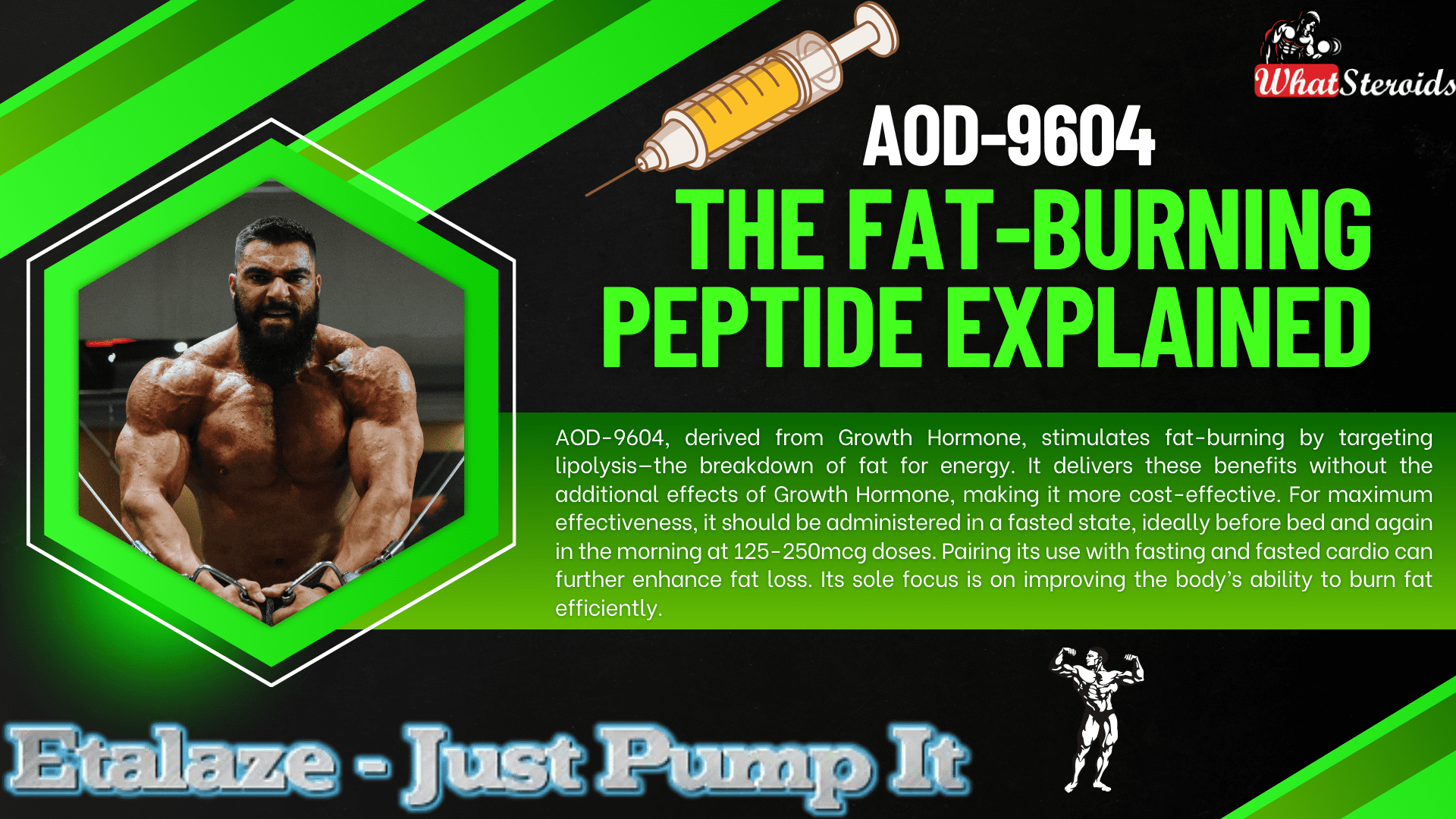
AOD-9604, along with the similar HGH Frag 176-191, is a peptide derived from Growth Hormone that includes only the amino acids in HGH responsible for stimulating fat breakdown, known as lipolysis.
This means that these peptides offer the fat-burning benefits of HGH without its other effects—whether beneficial or adverse—and come at a lower cost.
Related Article: Anavar Cycle for Men and Women
Lipolysis refers to the process where fat cells are broken down to be utilized as energy. AOD-9604 promotes accelerated fat loss by increasing the body's use of fat as fuel.
For optimal results, the peptides should be used in a fasted state. AOD-9604 and Frag 176-191 are most effective when administered at a dose of 125-250mcg before bedtime (at least 3-4 hours after eating) and in the morning at the same dose, followed by a fasting period of 3-4 hours, ideally combined with fasted cardio.
Check Out Dragontropin HGH 100 IU by Dragon Pharma
Similar Peptides with Fat-Burning Effect
Here’s a list of 10 peptides similar to AOD-9604, each with a brief description:
Ipamorelin: A growth hormone-releasing peptide (GHRP) that stimulates the natural release of growth hormone, promoting fat loss, muscle growth, and improved recovery without affecting other hormones like cortisol or prolactin.
CJC-1295: A peptide that increases growth hormone and IGF-1 levels, aiding in fat loss, muscle gain, and improved sleep quality. It has a long half-life, making it convenient for users.
HGH Frag 176-191: A fragment of human growth hormone specifically designed for fat-burning. It targets adipose tissue without the broader effects of full-length HGH.
Tesamorelin: Known for reducing visceral fat, this peptide stimulates the release of growth hormone and is often used for weight management and metabolic health.
BPC-157: While primarily known for healing and recovery, BPC-157 can support fat loss indirectly by improving gut health and reducing inflammation.
Melanotan II: Originally developed for skin tanning, it also has appetite-suppressing properties, making it useful for weight management.
Thymosin Beta-4 (TB-500): Focused on healing and recovery, it can enhance physical performance and indirectly support fat loss through improved activity levels.
GHRP-6: A growth hormone-releasing peptide that boosts appetite and metabolism, aiding in muscle growth and fat loss.
Semaglutide: A GLP-1 receptor agonist that regulates appetite and blood sugar levels, making it effective for weight loss and metabolic health.
MK-677 (Ibutamoren): A growth hormone secretagogue that increases growth hormone and IGF-1 levels, promoting fat loss, muscle gain, and improved recovery.
List of Peptides With a Counteractive Effect Bodybuilders Must Avoid
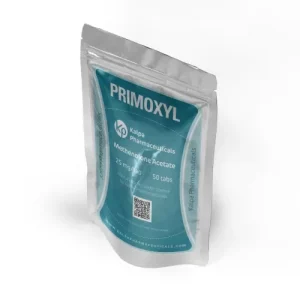 Click Here to Buy Primoxyl 25 by Kalpa Pharmaceuticals
Click Here to Buy Primoxyl 25 by Kalpa Pharmaceuticals
Some peptides can inadvertently lead to fat gain due to their effects on metabolism and appetite regulation. Here are a few that bodybuilders might want to avoid or use cautiously:
- GHRP-6 – While it stimulates growth hormone release, it also significantly increases appetite, which can lead to excess calorie consumption and fat gain.
- IGF-1 LR3 – This peptide enhances muscle growth but can also promote fat storage if not carefully managed with diet and training.
- MK-677 (Ibutamoren) – Though technically a growth hormone secretagogue rather than a peptide, it boosts GH levels but often leads to increased hunger and potential fat accumulation.
- CJC-1295 with DAC – While effective for muscle growth, its prolonged GH release can sometimes lead to unwanted fat retention if not paired with a strict diet
Overall
AOD-9604, derived from Growth Hormone, stimulates fat-burning by targeting lipolysis—the breakdown of fat for energy. It delivers these benefits without the additional effects of Growth Hormone, making it more cost-effective. For maximum effectiveness, it should be administered in a fasted state, ideally before bed and again in the morning at 125-250mcg doses. Pairing its use with fasting and fasted cardio can further enhance fat loss. Its sole focus is on improving the body’s ability to burn fat efficiently.
Read More: How Much Do You Know About B-AET? A Fat Burner You’ve Been Missing
Bodybuilding
Understanding Trenbolone-Induced Cough (“Tren Cough”)

Trenbolone, a potent anabolic steroid, can sometimes cause “tren cough”—a sudden and intense coughing episode shortly after injection. Although not exclusive to Trenbolone, it is more commonly associated with this substance due to its highly irritant nature.
 Click Here To Buy 1-Test Cyp 100 by Nakon Medical
Click Here To Buy 1-Test Cyp 100 by Nakon Medical
Mechanisms Behind Tren Cough
Solvent and Carrier Irritation
Trenbolone formulations often include volatile solvents like benzyl alcohol or benzyl benzoate, which may irritate lung tissues when absorbed quickly into systemic circulation.
Prostaglandin Release
Trenbolone promotes increased production of prostaglandins, particularly PGF2α. This compound triggers contraction in the smooth muscles of the lungs, leading to bronchoconstriction and coughing.
Micro-Oil Embolism
Tiny oil droplets from an injection can reach capillaries and travel to the lungs, causing mild embolic reactions that lead to temporary oxygen deprivation and coughing.
Histamine and Mast Cell Activation
For some individuals, Trenbolone triggers histamine release and mast cell activation, mimicking an allergic response and causing bronchospasms and cough reflexes.
Related Article: Best Syringes for Steroid Injection on Amazon
Using Salbutamol (Albuterol) to Manage Tren Cough
- Salbutamol, a widely-used β2-adrenergic receptor agonist, can alleviate tren cough symptoms by:
- Relaxing bronchial muscles, easing spasms that cause coughing.
- Inhibiting prostaglandin effects, reducing bronchoconstriction associated with PGF2α.
- Opening airways, preventing severe respiratory restrictions in susceptible individuals.
Application Methods
Inhaler (Optimal)
Take 1–2 puffs of salbutamol (100–200 mcg) 5–10 minutes before a Trenbolone injection. If coughing occurs afterward, additional puffs can swiftly resolve the issue.
Oral Tablets (Moderate)
Consuming 2–4 mg tablets 30–60 minutes before injection offers slower, longer-lasting relief but may be less effective than inhalation methods.
Nebulizer (Severe Cases)
For individuals with frequent episodes, nebulized doses of 2.5 mg salbutamol can provide substantial relief.
Preventive Measures to Reduce Tren Cough Risk
- Inject slowly to minimize systemic absorption and irritant effects.
- Split doses to lower reaction severity with smaller quantities.
- Opt for ventrogluteal injection sites, which have fewer blood vessels, reducing oil embolism risk.
- Choose lower-concentration solutions to lessen irritation, as higher concentrations (e.g., Tren Ace 200 mg/ml) are more likely to provoke reactions.
What Other Steroids Can Induce Coughing?
Here's a curated list of peptides, SARMs, and PEDs that may potentially cause coughing or respiratory irritation in bodybuilders and fitness enthusiasts:
Peptides
IGF-1 LR3 (Insulin-like Growth Factor): Known for its anabolic effects, IGF-1 LR3 can occasionally cause mild respiratory irritation due to systemic absorption.
TB-500 (Thymosin Beta-4): While rare, improper injection techniques or high doses may lead to transient coughing episodes.
GHRP-6 (Growth Hormone-Releasing Peptide): This peptide can stimulate histamine release, potentially leading to bronchospasms and coughing.
SARMs (Selective Androgen Receptor Modulators)
RAD-140: (Testolone) Some users report throat irritation or coughing, often attributed to solvents used in liquid formulations.
YK-11: Known for its myostatin-inhibiting properties, YK-11 may cause mild respiratory discomfort in sensitive individuals.
LGD-4033 (Ligandrol): Though uncommon, some users experience coughing due to carrier solvents or allergic-like reactions.
PEDs (Performance-Enhancing Drugs)
Boldenone Undecylenate (Equipoise): This injectable steroid can cause “Equipoise cough,” similar to tren cough, due to oil embolism or irritant solvents.
Testosterone Suspension: The water-based formulation may lead to coughing episodes if injected improperly or absorbed rapidly.
Nandrolone Decanoate (Deca-Durabolin): While less common, coughing can occur due to histamine release or systemic irritation.
More Tips to Minimize Coughing Risks
- Use proper injection techniques to avoid embolic reactions.
- Opt for lower-concentration solutions to reduce irritant effects.
- Consider antihistamines or bronchodilators for individuals prone to respiratory sensitivity.
Read More: Joint Stiffness: How to Manage It While on AAS
Are There Alternatives to Cough-inducing Steroids?
Here are some alternatives to cough-inducing steroids that can provide similar anabolic effects while minimizing respiratory irritation:
Peptides
IGF-1 LR3 (Insulin-like Growth Factor)
Promotes muscle growth and recovery without the irritant properties of certain steroids.
TB-500 (Thymosin Beta-4)
Enhances tissue repair and reduces inflammation, making it a safer option for recovery.
BPC-157 (Body Protection Compound)
Known for its healing properties, it supports muscle repair and joint health.
SARMs (Selective Androgen Receptor Modulators)
RAD-140 (Testolone)
Provides significant muscle-building effects with fewer systemic side effects compared to traditional steroids.
LGD-4033 (Ligandrol)
Boosts lean muscle mass and strength without the risk of respiratory irritation.
MK-677 (Ibutamoren)
Stimulates growth hormone release, aiding in muscle growth and recovery.
Natural Alternatives
Turkesterone
A plant-based ecdysteroid that supports muscle protein synthesis and recovery.
Ecdysterone
Another natural compound that mimics anabolic effects without the harsh side effects.
Creatine Monohydrate
Enhances strength and muscle mass through improved energy production during workouts.
Other Options
Human Growth Hormone (HGH)
Promotes muscle growth and fat loss, though it requires careful monitoring due to potential side effects.
Testosterone Boosters
Natural supplements like D-Aspartic Acid or Tribulus Terrestris can help optimize testosterone levels for muscle growth.
SARMs Alternatives
Legal and safer versions of SARMs are available, offering similar benefits without the risks associated with traditional SARMs.
Overall
We have explored the phenomenon of "tren cough," a sudden, intense coughing episode often caused by Trenbolone injections due to factors like solvent irritation, prostaglandin release, micro-oil embolism, or histamine activation. Preventive measures such as using salbutamol (via inhaler, oral tablets, or nebulizer), injecting slowly, splitting doses, and opting for lower-concentration solutions were highlighted.
Additionally, alternative compounds to tren cough-inducing steroids were discussed, including peptides like IGF-1 LR3 and TB-500, SARMs such as RAD-140 and LGD-4033, and natural options like Turkesterone, ecdysterone, and creatine. These alternatives provide anabolic effects while minimizing respiratory side effects. The conversation also underscored the importance of proper injection techniques and thoughtful compound selection to reduce risks.
Steroids
Creatine vs Myostatin: An Expert’s Analysis
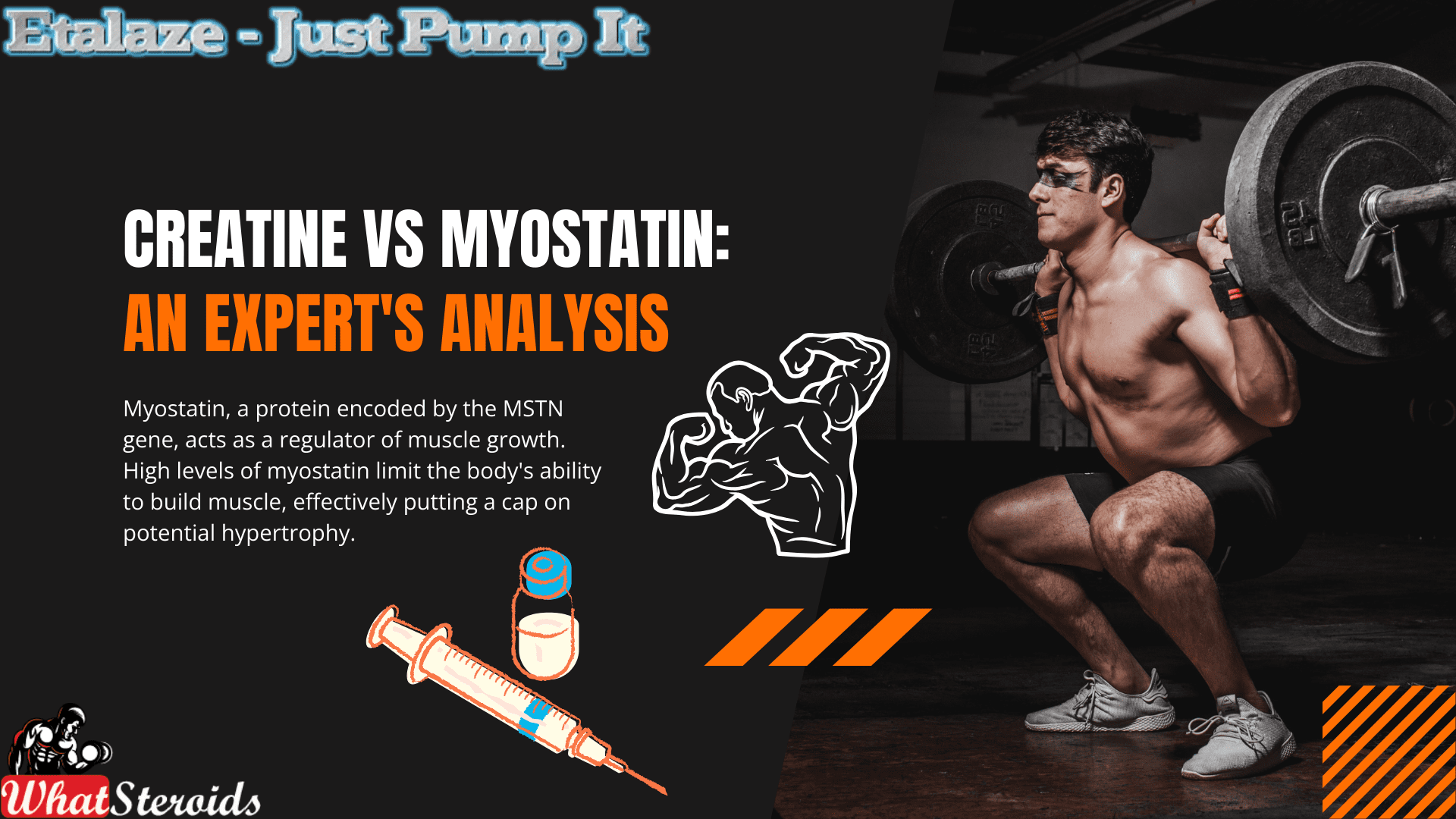
Myostatin, a protein encoded by the MSTN gene, acts as a regulator of muscle growth. High levels of myostatin limit the body's ability to build muscle, effectively putting a cap on potential hypertrophy. Inhibiting myostatin has become a focal point for bodybuilders looking to break through plateaus and achieve significant muscle gains. The question is: can creatine, a popular and widely available supplement, help in this regard?
Medical History of Myostatin and Creatine
Myostatin and creatine, while popular now in the bodybuilding world, have their roots in entirely different contexts:
Myostatin: Natural Muscle Growth Regulator
Myostatin is a protein originally identified for its role in regulating skeletal muscle mass. In nature, it serves an evolutionary purpose: by limiting muscle growth, it conserves energy, ensuring that animals (and humans) don’t expend unnecessary resources maintaining excessive muscle tissue. This was especially important in the wild, where energy efficiency could mean the difference between survival and extinction.
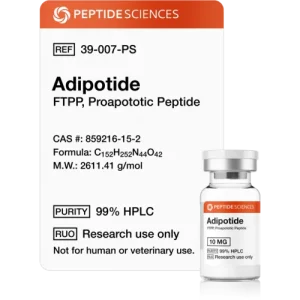 Check Adipotide (FTPP) 10mg by Peptide Science
Check Adipotide (FTPP) 10mg by Peptide Science
In the medical field, research into myostatin has focused on its role in muscle-wasting diseases. Scientists are exploring ways to inhibit myostatin to treat conditions like muscular dystrophy, where excessive muscle loss impairs quality of life. This therapeutic potential is where the idea of myostatin inhibition first began—long before bodybuilders latched onto the concept.
Creatine: Energy and Medical Applications
Creatine was originally studied for its role in energy metabolism. It’s a naturally occurring compound stored in muscle cells and plays a critical part in replenishing ATP (adenosine triphosphate), the body’s primary energy currency during short, high-intensity activities.
Before becoming a bodybuilding staple, creatine gained recognition in medical and sports science for its ability to improve athletic performance and assist with recovery. Furthermore, in medicine, creatine was investigated for neurological conditions such as Parkinson’s disease, Huntington’s disease, and muscular dystrophy, given its potential to improve muscle function and brain energy metabolism.
In the sports world, it was initially adopted by sprinters and weightlifters in the 1970s and 1980s for its energy-enhancing benefits.
Both myostatin and creatine have found new life in bodybuilding circles, demonstrating how discoveries in natural physiology and medical science can lead to transformative applications in fitness.
Benefits of Creatine as a Myostatin Inhibitor
Muscle Growth Potential: Research suggests that creatine, when paired with intense resistance training, may inhibit myostatin to a degree, fostering an environment for enhanced muscle growth.
Improved Exercise Performance: Creatine is well-known for its ability to increase ATP production, translating to better performance during high-intensity activities.
Versatility Across Fitness Levels
Whether you're a beginner or an advanced athlete, creatine offers benefits that complement various stages of muscle-building.
Must Read: A New Caffeine? What You Need to Know about Teacrine
Affordability and Accessibility
Compared to specialized myostatin inhibitors like YK-11 and ACE-031, creatine is significantly more affordable and accessible.
Side Effects of Creatine
While generally safe for most individuals, creatine supplementation does come with some potential side effects:
Water Retention: Some users experience bloating due to increased water retention in muscle cells.
Gastrointestinal Issues: High doses may lead to stomach upset or diarrhea.
Kidney Concerns: Although rare, prolonged excessive use could strain the kidneys, particularly in individuals with pre-existing conditions.
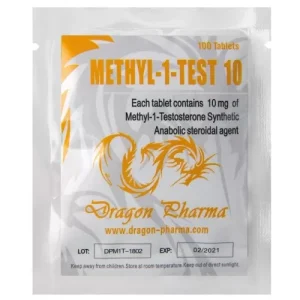 Buy Methyl-1-Test 10 -100 tabs by Dragon Pharma
Buy Methyl-1-Test 10 -100 tabs by Dragon Pharma
Alternatives to Creatine for Myostatin Inhibition
YK-11: A synthetic myostatin inhibitor derived from SARMs, offering more potent results but accompanied by more significant risks.
ACE-031: A peptide that directly inhibits myostatin, though it remains in experimental phases and is not legally approved in many regions.
Natural Alternatives
Follistatin-rich Foods: Eggs and dairy products may have natural myostatin-inhibiting properties.
Resistance Training: Intense and consistent weightlifting alone can naturally lower myostatin levels.
Where to Buy Creatine
Creatine is readily available worldwide. It can be purchased from:
Local Pharmacies and Nutrition Stores: Ideal for trusted and immediate access.
Online Platforms: Websites like Amazon, iHerb, or bodybuilding-specific stores offer a variety of brands and formulations.
Supplement Brands: Well-established brands such as Optimum Nutrition, MyProtein, and Cellucor often carry high-quality creatine.
Legality of Myostatin Inhibitors
Creatine: Creatine is completely legal and widely accepted as a dietary supplement.
YK-11 and ACE-031: These compounds exist in a legal gray area in many countries due to their experimental nature and potential risks. It's essential to research local laws before considering these options.
Best Stores and Suppliers
For reputable products, consider:
Transparent Labs: Known for purity and transparent labeling.
Optimum Nutrition: Offers pharmaceutical-grade creatine monohydrate.
Bulk Supplements: A great choice for bulk buyers seeking affordability and quality.
Our Advice to Bodybuilders
Always consult with a healthcare professional before starting any new supplement, especially if you are already using AAS or other advanced compounds.
Prioritize a balanced diet and consistent exercise routine. Supplements like creatine work best as part of a holistic approach to fitness.
Stay hydrated while using creatine to minimize water retention side effects and support kidney health.
Related Article: Best Syringes for Steroid Injection on Amazon
Overall
While creatine may not be as potent a myostatin inhibitor as advanced compounds like YK-11 or ACE-031, its affordability, safety, and accessibility make it a valuable addition to any bodybuilder's supplement stack. By leveraging its benefits alongside proper training and nutrition, you can maximize muscle growth and overcome plateaus, regardless of your fitness level.
-

 Steroids2 years ago
Steroids2 years agoShavers and Other Body Grooming Equipment for Bodybuilders In 2023
-

 Steroids2 years ago
Steroids2 years agoChatGPT and Other Avenues to Find Great Bodybuilding Coaches
-

 Steroids2 years ago
Steroids2 years agoBest Oil Recommendations Before Competition for Subtle Shimmer
-

 Steroids2 years ago
Steroids2 years agoPowerlifting Vs Power Building: Find Out the Big Difference and When to Shift Between the Two
-

 Nutrition1 year ago
Nutrition1 year agoEverything Nutritional Food: What’s Too Much Or Too Little
-

 Bodybuilding Products1 year ago
Bodybuilding Products1 year agoTelmisartan In Bodybuilding: An Expert’s Advice
-

 Anabolic Steroids1 year ago
Anabolic Steroids1 year agoLegality of Anabolic Steroids In Latin America
-

 Beginners2 years ago
Beginners2 years agoTren Cycle for Beginners
-

 Bodybuilding1 year ago
Bodybuilding1 year agoList of FDA-Approved Peptides
-

 Bodybuilding2 years ago
Bodybuilding2 years agoCompetition Prep Cycle for Pro Bodybuilders
-

 Bodybuilding1 year ago
Bodybuilding1 year agoChia Seeds in A Bodybuilder’s Diet: An Expert’s Advice
-

 Bodybuilding8 months ago
Bodybuilding8 months agoPrimal Movements: Our Ultimate Guide for Maximum Results
-

 Anabolic Steroids9 months ago
Anabolic Steroids9 months agoJoint Stiffness: How to Manage It While on AAS
-

 Steroids12 months ago
Steroids12 months agoAnadrol Cycle: Benefits, Doses, Alternatives, etc.
-

 Steroids10 months ago
Steroids10 months agoOmnitope (Oxytocin)
-

 Bodybuilding8 months ago
Bodybuilding8 months agoHow Effective is Bone Broth for Recovery?
-

 Bodybuilding1 year ago
Bodybuilding1 year agoHow Much Is Too Much Cardio? Understanding Heart Rate Zones
-

 Anabolic Steroids11 months ago
Anabolic Steroids11 months agoHow Much Do You Know About B-AET? A Fat Burner You’ve Been Missing
-

 Steroids9 months ago
Steroids9 months agoSleeping Positions for Effective Muscle Recovery
-

 Bodybuilding1 year ago
Bodybuilding1 year agoCalorie Dumping: A Bodybuilder’s Guide
-

 Product Reviews11 months ago
Product Reviews11 months agoTop Vitamins for Skin Health
-

 Bodybuilding7 months ago
Bodybuilding7 months ago2nd Edition of Natural Bodybuilding Competition Facts
-

 Bodybuilding1 year ago
Bodybuilding1 year agoDemystifying Hypertrophy Training
-

 Bodybuilding8 months ago
Bodybuilding8 months agoAre Nootropics a Better Option to AAS?
-

 Steroids11 months ago
Steroids11 months agoMajor Bodybuilding Peptides Explained

